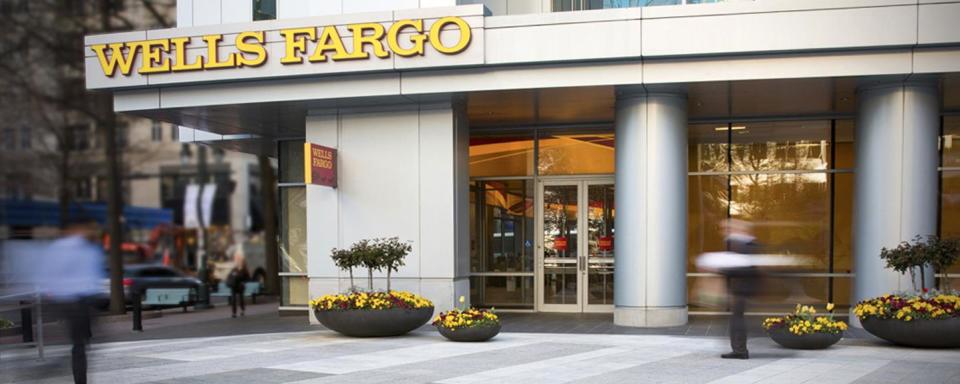Is Wells Fargo a Buy?
If someone handed out prizes for Least Loved Big American Bank, Wells Fargo (NYSE: WFC) would be the winner several years running. The controversial lender just can't seem to stop making headlines for the wrong reasons. This began with its "fake accounts" scandal of 2016, and has continued with a fresh set of controversies.
So far this year, they already include a systemwide outage and an effective $1 million raise for its CEO that many think is undeserved. Since the fake-accounts scandal broke, Wells Fargo has been the sick man of the "big four" U.S. banking incumbents, with a stock price that has notably trailed its three rivals (as well as the S&P 500, while we're at it). But maybe, just maybe, that means there is some value to be had in the shares.

Image source: Wells Fargo.
Wells isn't well
Those mistakes are frequent and infuriating. As investors, we hate to see one of our companies making what seem like constant stumbles. In the decade since the financial crisis, JPMorgan Chase (NYSE: JPM), Bank of America (NYSE: BAC), and Citigroup (NYSE: C) have all operated cleanly, more or less. It can't be that hard to stay out of trouble.
The Fed's 2018 decision to bar Wells Fargo from growing its assets came at an extremely inopportune time. The U.S. economy has been on an unprecedented march upward since the ugliness of last decade's financial crisis. Banks are cyclical; by and large, they do well when the economy is heading north. Wells Fargo is missing the party.
At the start of 2018, I made the fairly obvious call that the year wouldn't be a standout one for Wells Fargo. In that article, I had a graph tracking key year-over-year line items for the company and the rest of the big four, plus average analyst estimates for revenue and EPS growth. Updating that with the banks' most recently reported quarterly results reveals that Wells Fargo remains a laggard:
Bank | Net rev. growth (decline) YOY | Net profit growth YOY | Loans growth YOY | Efficiency ratio | 1-year forward EPS growth | 1-year forward rev. growth |
Wells Fargo | (10%) | 1% | (1%) | 64% | 15% | 1% |
JPMorgan Chase | 7% | 67% | 5%* | 60% | 8% | 3% |
Bank of America | 11% | 208% | 5% | 45% | 11% | 3% |
Citigroup | (2%) | N/A | 3% | 57% | 14% | 3% |
Sources: Yahoo! Finance, Wells Fargo, JPMorgan Chase, Bank of America, Citigroup. YOY = Year over year.* Core loans (defined as " loans considered central to the firm's ongoing businesses")
The neutral zone
Some investors perked up when Wells Fargo reported not-half-bad numbers in its third quarter last year.
This showing was pleasant, but many of the company's key line items and valuations went in the opposite direction in the fourth quarter -- so the improvements were marginal and don't seem to be permanent. This tells me that the bank isn't doing a good enough job regaining the trust and business of American consumers. This is a big problem with an erosion of reputation: Such damage can take a long time to repair.
On top of that, the Fed is keeping its wary eye on Wells Fargo. It has yet to lift the asset growth ban, and there's no indication it's going to anytime soon. Meanwhile, some pundits speculate that the long-burn economy will cool down before long. If it does while Wells Fargo is still stuck in asset neutral, the bank is in for more pain and struggle.
To be fair to the company, it does have quite a few things going for it. Wells Fargo is still a dominant player in the all-important mortgage segment, while other activities (like small-business lending) have been growing robustly. Also, it's been devoting much capital lately to stock buybacks and dividend boosts. In fact, the stock's current dividend yield around 3.7% is tops among the big four, well outpacing No. 2 JPMorgan Chase.
But at the end of the day, this is a company that hasn't taken advantage of this end of the long-tail U.S. growth economy -- and probably won't. Bank of America, Citigroup, and JPMorgan Chase might be pricier in terms of valuations and more miserly with their dividend payouts, but they generally enjoy the confidence of the banking public and the grace of regulators. And unlike Wells Fargo, they are actually permitted to grow.
More From The Motley Fool
Eric Volkman has no position in any of the stocks mentioned. The Motley Fool has no position in any of the stocks mentioned. The Motley Fool has a disclosure policy.

 Yahoo Finance
Yahoo Finance 